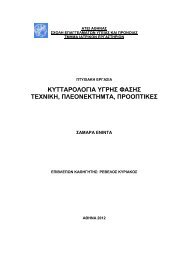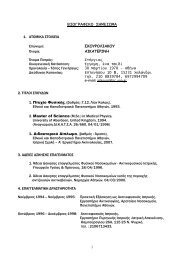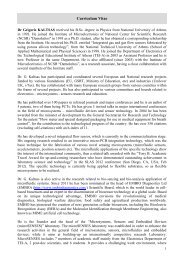Μία σύντομη εισαγωγή
Μία σύντομη εισαγωγή
Μία σύντομη εισαγωγή
- TAGS
- users.teiath.gr
Create successful ePaper yourself
Turn your PDF publications into a flip-book with our unique Google optimized e-Paper software.
tan( A) + tan( B)<br />
tan( A+ B) = tan( π −C) ⇒ =−tan( C)<br />
⇒<br />
1−tan( A)tan( B)<br />
tan( A) + tan( B) =−(1−tan( A) tan( B)) tan( C)<br />
⇒<br />
tan( A) + tan( B) =− tan( C) + tan( A) tan( B) tan( C)<br />
⇒<br />
tan( A) + tan( B) + tan( C) = tan( A) tan( B) tan( C)<br />
3<br />
6. Να αποδειχθεί ότι για κάθε x ∈ ισχύει: sin(3 x) = 3sin( x) − 4sin ( x)<br />
Λύση:<br />
sin(3 x) = sin(2 x+ x) = sin(2 x)cos( x) + sin( x)cos(2 x)<br />
=<br />
2<br />
2sin( x)cos( x)cos( x) + sin( x)(1− 2sin ( x))<br />
=<br />
2 3<br />
2sin( x)(1− sin ( x)) + sin( x) − 2sin ( x)<br />
=<br />
3 3<br />
2sin( x) − 2sin ( x) + sin( x) − 2sin ( x)<br />
=<br />
3<br />
3sin( x) − 4sin ( x)<br />
3<br />
7. Να αποδειχθεί ότι για κάθε x ∈ ισχύει: cos(3 x) = 4cos ( x) − 3cos( x)<br />
Λύση:<br />
cos(3 x) = cos(2 x+ x) = cos(2 x) cos( x) −sin(2<br />
x)sin( x)<br />
=<br />
2<br />
(2cos ( x) −1)cos( x) − 2sin( x)cos( x)sin( x)<br />
=<br />
3 2<br />
2cos ( x) −cos( x) −2cos( x)(1− cos ( x))<br />
=<br />
3 3<br />
2cos ( x) −cos( x) − 2cos( x) + 2cos ( x)<br />
=<br />
3<br />
4cos ( x) − 3cos( x)<br />
4<br />
8. Να αποδειχθεί ότι για κάθε x ∈ ισχύει: 8sin ( x) = 3− 4sin(2 x) + cos(4 x)<br />
Λύση:<br />
4 4 2 2<br />
2<br />
8sin ( x) = 2(4sin ( x)) = 2(2sin ( x)) = 2(1−cos(2 x))<br />
=<br />
2 2<br />
2(1− 2cos(2 x) + cos (2 x)) = 2− 4cos(2 x) + 2cos (2 x)<br />
=<br />
2 − 4cos(2 x) + 1+ cos(4 x) = 3− 4sin(2 x) + cos(4 x)<br />
9. Να λυθεί στο [0,2π] η εξίσωση cos(2 x) − 3sin( x)<br />
+ 1 = 0 .<br />
Λύση:<br />
Παρατηρούμε ότι<br />
2<br />
cos(2 x) − 3sin( x) + 1 = 0 ⇔1−2sin ( x) − 3sin( x)<br />
+ 1 = 0<br />
2<br />
2sin ( x) + 3sin( x)<br />
− 2 = 0<br />
Οπότε εάν θέσουμε y = sin( x)<br />
η εξίσωση είναι ισοδύναμη με την<br />
2<br />
1<br />
2y + 3y− 2=0με<br />
y ∈− [ 1,1] . Η δευτεροβάθμια αυτή έχει ρίζες ρ1 = , ρ2 =− 2 από τις<br />
2<br />
1<br />
οποίες η δεύτερη απορρίπτεται. Από την ρ 1 = έχουμε<br />
2<br />
⇔<br />
10

















